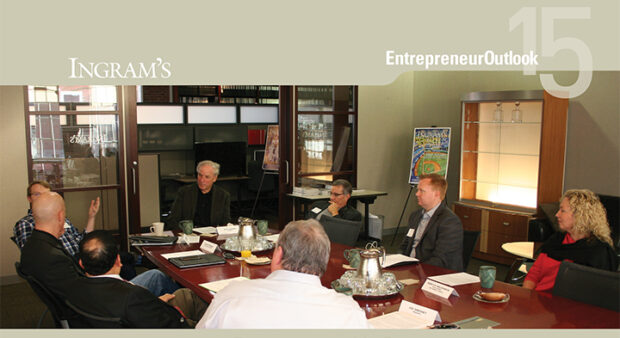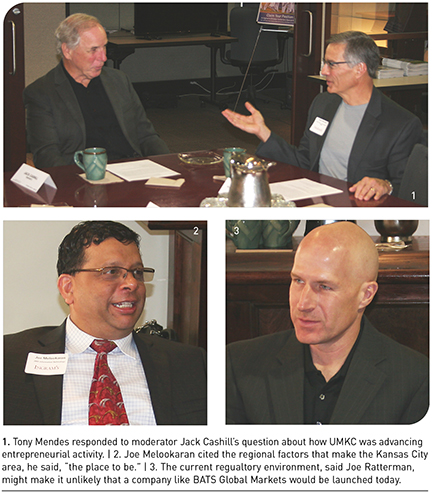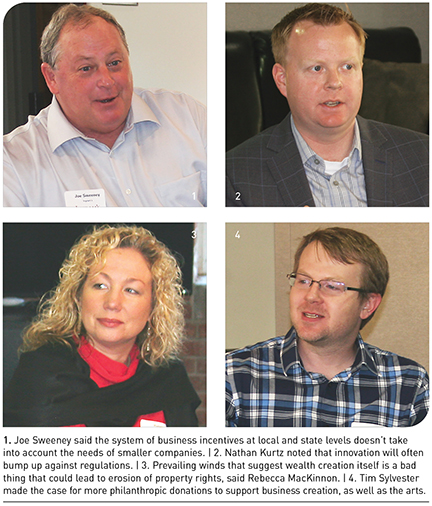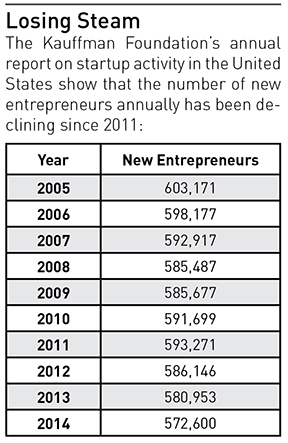HOME | ABOUT US | MEDIA KIT | CONTACT US | INQUIRE
HOME | ABOUT US | MEDIA KIT | CONTACT US | INQUIRE

Participants: Joe Ratterman, BATS Global Markets | Tim Sylvester, Integrated Roadways | Tony Mendes, Regnier Center for Entrepreneurship and Innovation, UMKC | Nathan Kurtz, Kauffman Foundation | Rebecca MacKinnon, Mid America Angels | Joe Melookaran, JMA Information Technologies | Jack Cashill, Ingram’s | Joe Sweeney, Ingram’s.
In early November, Ingram’s editors gathered several leading business minds in the region for an intimate think-tank session on entrepreneurship.
We jumped right in by asking our guests what the Kansas City area could do to make itself more conducive to launching and sustaining businesses. Tim Sylvester suggested that other cities in the region do what Mayor Sly James has done in Kansas City, namely removing any limitations that a city has on buying products and services from vendors.
Sylvester is the founder of a promising young company called Integrated Roadways. While still in school, he recognized that infrastructure was the largest market that had not been completely changed by information technology. So he experimented in the production of factory-built, prefabricated roadway with an IT component embedded within it.
In a competitive-purchase environment, “smart” pavement is a tough sell because it costs more to install, but unlike any other form of pavement, it can actually generate revenue for a city or state with its digital capacity. It is for this reason that Sylvester appreciates flexibility from decision-makers.
Joe Ratterman, chairman of the board at BATS Global Markets, considers the Kansas City area an “awesome place to build a business,” one with few gratuitous regulatory obstacles. BATS has done quite well by Lenexa, and before that, Parkville. Just 10 years ago, Ratterman deviated from a well-established career path as CIO at LabOne to join a handful of others in what must have seemed an impossible dream to outsiders, namely building “this gigantic thing,” a stock exchange in Kansas City. For the record, BATS originally meant “Better Alternative Trading System.”

Today, BATS employs more than 300 people, has eclipsed NASDAQ, runs the largest stock exchange in Europe, and is breathing hard on the New York Stock Exchange for equities-trading share. Ratterman credits some of the company’s success to the SEC model of regulatory oversight: that is, not burdening a company with regulation until the company proves its business model is sustainable. That said, he concedes that in the past eight to 10 years, “the federal regulatory environment has definitely grown significantly.” Given those changes, he is not sure BATS could have accomplished what it has were it starting today.
Rebecca MacKinnon has had less a sanguine experience with bureaucrats. “I think they need to drop the attitude,” said MacKinnon. She acknowledged that regulators play a potentially important role in keeping capitalism vibrant and healthy, but in the past decade, she has seen the regulatory environment adopt the attitude that, “If you desire to make money, you’re doing something wrong and we’ve got to stop that.”
MacKinnon is part of Mid America Angels, a local angel investment group. She started her first company in 1994 and grew it from inception to acquisition. She is now involved in her fifth entrepreneurial venture. Having grown up on a family farm, MacKinnon has spent much of her energy on nurturing electronic technology that helps the farmer.
Tony Mendes, the managing director at the Regnier Institute for Entrepreneurship and Innovation at UMKC, refers to the regulatory attitude as “the mindset.” He sees it as a constant, one not easily resolved. “You’re always going to have entrepreneurs looking at innovative ways of doing business. But then you have the bureaucracy trying to implement the mindset that things need to be regulated.”
“At risk of oversimplifying with a metaphor, regulators are supposed to be like janitors,” said Sylvester, “but they’ve begun acting like landlords.”
Nathan Kurtz, senior program officer in entrepreneurship for the Ewing Marion Kauffman Foundation, focuses on barriers to entrepreneurs, things as simple as hairdressers needing to have a state license to practice. “The purpose of a business is to create a customer,” said Kurtz. Once that it is established, the challenge often is to make sure that the service is legal. Sometimes—in the case of Uber, for instance—establishing a business’s legality takes a reworking of old regulations.

Ingram’s publisher Joe Sweeney argued that local governments need to shift their incentive strategy from aiding large companies to helping smaller ones. Luring established businesses from one side of the state line to the other, said Sweeney, represents “a net gain of nothing.” Swe-eney started his first business at 13, a lawn care company, with a bank loan of $15,000 for a tractor, co-signed by his dad.
Joe Melookaran, president of JMA Information Technology, agreed with Sweeney, “There should be more focus on smaller and mid-size businesses with some of the incentives,” he observed. That said, he has not found the regulatory environment particularly punitive. “Nothing is holding us back,” he said, “but it could be better if we could create an environment to promote business”.
When Melookaran arrived from India with his CPA 32 years ago, the best job he could find was selling shoes at the mall. Like many entrepreneurs, Melookaran adapted his business strategy to the needs of a continually changing market place, shifting from IT staffing to application development and other IT work. The company employs about 300 people in the U.S. and 100 in several Asian markets.
Tim Sylvester made the case that government cannot be the angel for start-ups. “We have so many very well-established people in the city that donate a lot of money for the arts and philanthropy in general,” he observed, “but not [much] goes into entrepreneurship.”
He advocated a shift in thinking: instead of setting aside 1 percent for art, as with city-funded projects, 1 percent be invested in entrepreneurship. “When you’re donating money to philanthropy, there is zero ROI,” he noted.
Joe Ratterman was not quite as pessimistic. He cited several new funds, including Flyover Capital, to which he himself subscribes. “I’m thinking of it almost as a charitable donation,” he said, but he believes it important to make sure money is available for firms that want to stay in the Midwest.
The question was raised as to whether tax policy favors philanthropy over investment in start-ups. “Assuming that at least some portion of [philanthropy] is driven by tax policy,” said Sylvester, “having access to the angel tax credits in Missouri could go a long way to alleviate that.”
Kurtz noted that the Kauffman Foundation through its Fellows program has been teaching venture capitalists to do better work. MacKinnon is among the program’s biggest fans. “That program,” she said, “has single-handedly improved the way in which venture capital works with its startup companies and the way in which it accepts failure.

Beyond private and public incentives, Tony Mendes saw the virtue in creating an environment that would attract the kind of people inclined to start companies. “How do we do that?” he asked, citing Portland as an example. “I think that would be a great way to really look at the future of Kansas City as a creative environment.”
Rebecca MacKinnon had a slightly different take on environment. “Making money is a good thing,” she argued. “Making money means economic indep-endence.” That is a mindset she believes we ought to encourage whether a person lives in Downtown Kansas City or Archie, Mo.
“Some people have this odd attitude that success is wrong,” said Tim Sylvester, “that they should not be proud of the wealth they have created.” This is not an attitude that fosters growth.
“Peer-to-peer mentoring works,” said Nathan Kurtz. “If you can have someone who’s been there before who can pull entrepreneurs up, that’s one of the most important things we can do as a community.”
UMKC is encouraging the spread of the entrepreneurial spirit through a number of programs, said Tim Mendes. He cited one program in which non-business students look at potential products and services for Baby Boomers. “You can’t just [meet this need] through philanthropy,” said Mendes. “The students are forced to look at it through a business perspective.”
In a similarly practical vein, the Kauffman Foundation hosts a workshop in which participating students are expected to identify a real need and create a potential solution over the course of a weekend. “We’re doing a lot on the early side,” said Kurtz about this and other programs. “How can we help entrepreneurs get started?”
“The tone the media sets is incredibly important,” said Rebecca MacKinnon. “I think we’re getting better again. I think we’re coming back to celebrating entrepreneurship. We went through some dark times for five or six years.”
Joe Melookaran had good words to say about the print media. In his opinion, they done a generally good job highlighting entrepreneurship and innovation. He was less keen on the broadcast media.
Joe Ratterman cited Ingram’s as one of the few media to “celebrate success.” He was not bullish on the national media. In his experience, they used the rise of BATS as a way of pulling down its competitors, like NASDAQ or the NYSE. “I don’t think media is helpful for start-ups and entrepreneurs,” said Ratterman. “The moment one fails, there’s a good chance there will be story about why it didn’t work.”
Nathan Kurtz faulted other local media for placing more emphasis on real estate development than on entrepreneurship and high-tech projects.
For all the talk of a shortage of high-quality labor in the Kansas City region, Joe Ratterman has not experienced it. “We found almost all of our talent here in the Nebraska-Kansas-Missouri triangle,” he noted. BATS has only brought three people in from out of the area in more than eight years of recruiting.
The region’s diversity—or lack there-of—has occasionally vexed Joe Melookaran, especially the lack of a sizable Asian population, a situation that often troubles a spouse more than the potential recruit.
In terms of retention, Tim Sylvester marveled at how sophisticated local engineering firms were in keeping employees in place through ownership buy-in. The downside is that start-ups have a hard time luring away talent “on promises that things will be gorgeous in the future.”

In this regard, Rebecca MacKinnon believes that mentorship can be of value to small companies. “This is a city that I have found that having ownership means all the difference in terms of how people view being a part of the company and remaining a part of the company,” she said.
“When I think of Kansas City,” said Tony Mendes, “I can’t help but think of it as a business.” This means identifying the core competencies and building on them. “There is something about Kansas City that makes it a good place to run a business, to start a business, grow a family,” he said, “and we should emphasize that.”
For years, Ingram’s has urged the business community to consider positioning the region in a serious way as the nation’s entrepreneurial capital. A few years ago, the Greater KC Chamber adopted this concept as one of its Big Five ideas. We asked our participants how they would make this positioning strategy real.
“I would plant a million seeds,” said Tony Mendes. He would start in grade school. He cited an entrepreneurial project in which his daughter was involved and asked, “How do we get entrepreneurship experiences like that all through the educational system here in Kansas City, right up through higher education?”
Nathan Kurtz commended the city of Kansas City, Missouri for making it much easier to get a new business license and asked why that same streamlining cannot be applied to renewals.
“I don’t look for the city to do anything for me,” said Rebecca MacKinnon. Her wish is that government would “get out of the way.”
Joe Sweeney would like to see governments define a portfolio of benefits and ED incentives that are more functional and fair for all firms than those now in place. He also argued for a more structured alignment of investors and mentors.
Joe Ratterman would like to see an entity that provides the tax, legal, financial, and communication support a would-be entrepreneur needs so he can better focus on his key idea. An entity like this “could take away a lot of the noise and let the idea get most of the energy.”
Tim Sylvester had two specific proposals. One, have philanthropists who are donating more than $1 million shave off 1 percent of that for investment into a deserving startup. The second would have larger corporations set aside the budgetary allocation for a single employee and invest it instead in a startup that is either developing a product or service that the company could use or that might develop into a likely acquisition at some future date.
As an immigrant, Joe Melookaran has a keen appreciation of the area’s virtues. “We have to play up the strength of Kansas City,” said Melookaran. He cited the low cost of living, a great community spirit, excellent schools, a solid investor base, and the variety of companies. He added, “I tell everybody that this is the city to be in.”